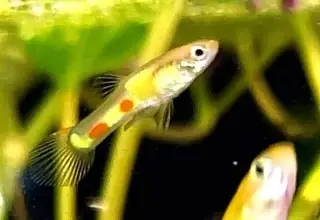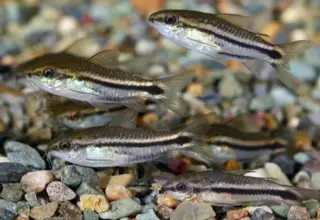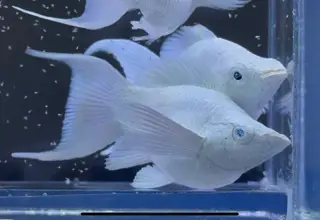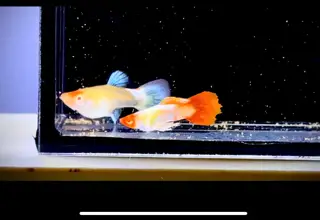Galaxy Koi Betta: Care, Tank Setup, Breeding & More
Posted by Miles Harrison on 09/05/2022
With so many types of Betta fish, it can be hard to pick a favorite. From solid colors to striped patterns, Betta fish have been bred to produce some of the most unique color combinations available in the freshwater aquarium hobby.
One of our favorites, the Galaxy Koi Betta, is easy to care for and makes a great addition to a large community tank or nano aquarium.
This post will provide you with all of the information needed to care for a Galaxy Koi Betta. You’ll learn about recommended water parameters, the life expectancy of the fish, and even guidance on breeding this unique strain!
January's Giveaways on Light Fish
Species Summary
Galaxy Koi Bettas are a color variant of Betta splendens. This freshwater fish is native to Southeast Asia, where it was first domesticated over 1,000 years ago. Selective breeding has produced numerous strains of betta fish with unique colors, fin shapes, and sizes.
Betta splendens are also referred to as Siamese fighting fish and are one of 73 species in the Betta genus. The “Siamese fighting fish” name is due to their territorial personalities. These fish will show signs of aggression towards any fish who dare to encroach on their territory!
Galaxy Koi Bettas prefer living in an environment that closely resembles their natural habitat. In the wild, betta fish live in shallow, slow-moving streams, stagnant ponds, and rice paddies.
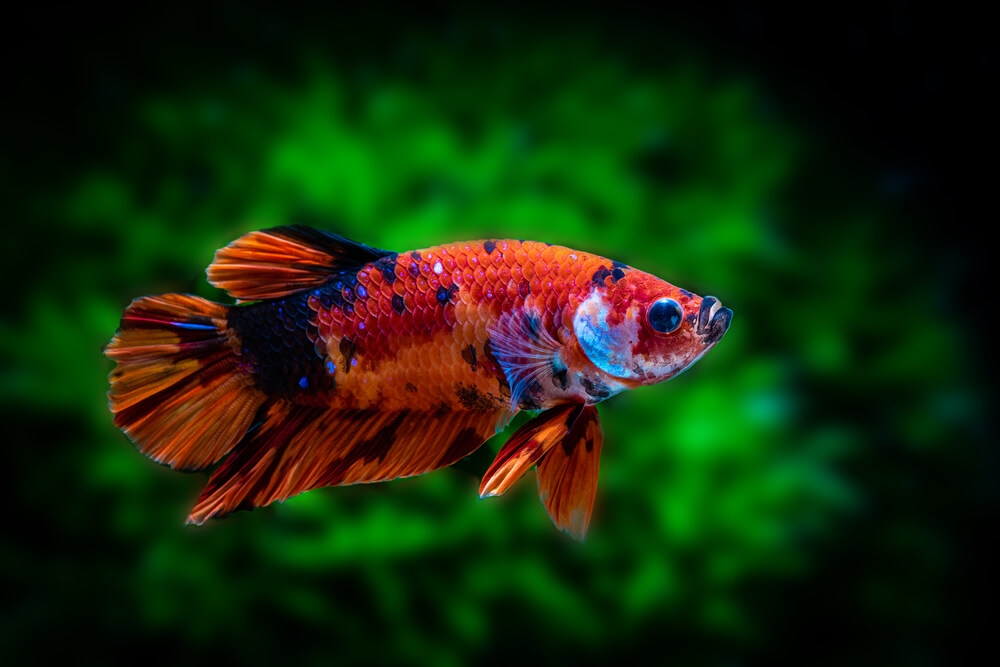
Galaxy Koi Betta Lifespan
With proper care, Galaxy Bettas can live in captivity for 2-5 years, a great lifespan for such a unique fish!
The lifespan of a Galaxy Koi Betta largely depends on how they’re treated. Maintaining pristine water conditions, providing an optimal diet, and being sure not to stress your fish by adding aggressive tank mates will allow your galaxy betta to live a healthy and happy life.
🛒 Shop Freshwater Fish on Light Fish
What does a Galaxy Koi Betta look like?
These fish have a very unique appearance. Their most distinctive feature is a wide array of spotted colors present on their fins and body that some say resemble stars in a galaxy. Galaxy Koi Bettas have been bred to include the full spectrum of colors and can have virtually any combination of colors on their bodies. These fish also share color patterns that resemble that of a Koi fish.
All Galaxy Koi Bettas will have slender bodies, with both dorsal and pectoral fins that the fish will use to swim and hover in place.
Tail Variations
Galaxy Koi Betta’s will typically have one of 5 different tail types. They are known as the Veil Tail, a long fin that arches upwards and then down, the Crown Tail, which looks like a web of tail spikes, the Halfmoon, a 180° fan-like tail, the Dumbo (or Elephant Ear betta), which features large pectoral fins, usually accompanied by a half moon tail. Last, there is the rosetail, a tail similar to the half moon which has ruffled edges.
Galaxy Koi Betta size
Galaxy Koi Bettas are a bit larger than common aquarium fish such as tetras and minnows. These active fish can grow to be about 3 inches in length, but will typically average somewhere between 2-3 inches for most hobbyists. As a result, you’ll want to have an aquarium of at least 5 gallons to house this species.
Galaxy Koi Betta care
Betta fish are very beginner-friendly, and aquarists will be pleased to know that the Galaxy variant of Betta splendens requires no special care. One of the biggest misconceptions when caring for betta fish is that they can live in a small aquarium without a heater and proper filtration. Nothing can be further from the truth, as this species requires a heater, proper filtration, and an aquarium of at least 5 gallons in size.
Galaxy Koi’s require a cycled tank, you’ll want to be sure that Ammonia and Nitrite levels remain at 0ppm. If your tank isn’t cycled yet, keep testing your aquarium water until you’re reaching this level consistently. Beneficial bacteria can be added to kickstart the nitrogen cycle in aquariums if needed, but if you’re comfortable with waiting, these bacteria will appear naturally over time, usually somewhere between 2-3 weeks.
Bettas prefer slightly acidic water similar to their native habitat. pH levels should be between 6.5-7.5. Luckily these fish are capable of adapting to hard water conditions. If you live in an urban environment where water tends to be a bit on the hard side, Galaxy Koi Betta can adapt without showing signs of stress. As with most freshwater fish, you’ll want to avoid drastic changes in water chemistry. Moving a betta fish from an aquarium with soft water, into an aquarium with high pH can be lethal to a betta fish. Always gradually introduce the fish to new water conditions by drip acclimating them.
Common Diseases
Galaxy Koi Bettas are susceptible to the same common diseases that challenge many betta fish owners.
One of the most common diseases is known as Fin Rot. Fin Rot occurs when water conditions are poor, or the betta fish is under excessive amounts of stress. The underlying disease is usually a fungal or bacterial infection. The best way to cure fin rot is by addressing the root problem - poor water quality.
Most betta diseases such as Pop Eye and Ich are often caused by poor water quality. Although we won’t get into covering every disease and treatment in this post, one thing is for sure. Keeping up with weekly 20-30% water changes will ensure that your Galaxy Koi Betta fish will remain healthy and disease-free.
Setting Up An Aquarium For Galaxy Koi Betta
Before purchasing a Galaxy Koi, you’ll want to have an established, fully cycled aquarium that’s at least 5 gallons in size, with no other tankmates. Betta fish have earned their alternate name, Siamese Fighting Fish for a reason. If you decide to add some tankmates, you’ll want to take extra precautions. We’ll get into tankmates a bit more later.
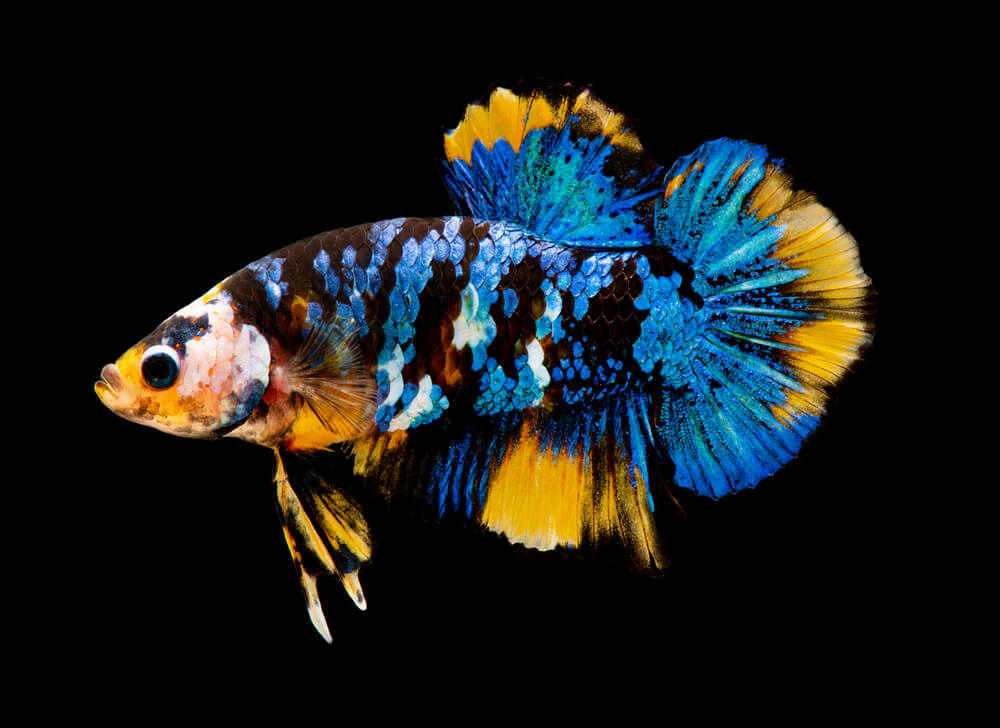
Let’s talk about equipment. These fish prefer living in slow-moving bodies of water, and although you’ll want to have the aquarium water consistently filtered, you won’t need a high volume of water turnover rate. Hang on the back filters (HOB), or a canister filter that is appropriate for your aquarium size will be perfect. Betta fish do not require adding extra powerheads or pumps.
If the current is too strong, Betta fish will try and find a place to rest outside of the water flow in the tank.
One thing to be mindful of is your aquarium water intake. If you have a strong filter, such as an EHEIM canister filter, the intake might be too strong, resulting in your betta fish potentially getting trapped in the filter! This mistake can be fatal, so if you have a strong filter, you’ll want to cover the intake with a piece of foam mesh. This material will allow water to flow freely through the filter, but will prevent your Galaxy Koi Betta from getting stuck!
Betta fish are also known jumpers. If water conditions are poor, these fish may try and escape by jumping out of the tank! They also enjoy the occasional swim against the current. If the current is too strong, these fish may swim so fast that they can jump right into the air. Providing a secure lid will prevent your betta fish from jumping out of the tank.
For the bottom of the aquarium, Betta fish are not very picky when it comes to different types of substrate. We recommend a smooth substrate, in fact, any of the substrates we recommend for Discus fish will be perfect for your Galaxy Koi!
Now, let’s discuss tank decorations. Betta fish can be startled quite easily, so you’ll want to provide plenty of hiding spots for your betta fish.
Building small caverns out of natural stones or rocks will be much appreciated by a Galaxy Koi. However, if we could only add one thing to an aquarium housing a betta, it would have to be aquatic plants. Live freshwater plants help naturally filter the water, are gentle on fins, and add a wonderful splash of color to an existing tank.
Food and diet info
Galaxy Koi Bettas are easy to satisfy and will accept a wide variety of food. They love indulging in freeze-dried foods, live foods such as bloodworms and brine shrimp, and flake and pellet food.
These fish will rarely pick at algae, so you’ll want to feed your Galaxy Koi Betta at least once a day, but ideally twice a day, once in the morning, and once at night would be preferred.
One mistake first-time betta owners will make is overfeeding their fish, resulting in constipation. It’s easy to spot a constipated Galaxy Koi Betta fish, as their stomach will bulge and they will appear to have a bloated belly. They also may have difficulty swimming. It’s best to withhold feeding for a day or two until constipation diminishes. If your Galaxy Koi is still having trouble, you can provide a peeled pea, which should help their digestive tract. In most cases, constipation in Galaxy Koi Betta fish will resolve itself in a few days.
In addition to constipation, overfeeding your fish can cause excess waste to accumulate on the bottom of the aquarium, which can cause an ammonia spike. Ammonia spikes should not be taken lightly, as a sudden increase in ammonia can prove fatal for a betta fish. If you suspect an ammonia spike, you should do 20% water changes every day for 2-3 days to re-balance your water chemistry.
Behavior & temperament
Hobbyists will enjoy observing the behavior of a Galaxy Koi Betta. Given pristine water conditions, these fish are highly active. They have curious personalities, and will constantly be inspecting the tank for any potential new food sources. At night these fish are mostly dormant and will rest along the substrate or in the leaves of an aquatic plant. However, when the sun comes up, these fish are active swimmers. These fish will even greet their owners when they approach the glass! Betta fish are an intelligent species and prefer having physical and mental stimulation throughout the day.
Another interesting thing about the Galaxy Koi Betta is its ability to conserve oxygen. Aquarists will notice these fish frequently swimming to the surface of a tank to replenish their oxygen supply. In a worst-case scenario where a betta fish jumps out of a tank, they’ll survive for up to an hour outside of water. This unique feature classifies them as labyrinth fish, which is defined as a fish that can take in oxygen from both its mouth and gills.
One of the most exciting traits of a Galaxy Koi Betta is its ability to blow a bubble nest. Often triggered by the presence of a female, Male bettas will build nests to impress potential suitors and provide oxygen-rich air for eggs. These nests can vary in size, and the bubbles are coated with saliva to increase their durability!
Tank mates
Most hobbyists will agree that the best tank mate for a Galaxy Koi Betta is no tank mate at all. But if provided a large enough aquarium, this isn’t necessarily true. Galaxy Koi Betta will co-exist quite comfortably with Cherry Shrimp, Ghost Shrimp, Amano Shrimp, snails such as Assassin, Nerite, and Mysteries, as well as amphibians such as African Dwarf Frogs.
Keeping Galaxy Koi Betta with tankmates successfully largely depends on two things. Tank size, and providing ample hiding spots. A heavily planted aquarium that is over 5 gallons will allow a betta to co-exist quite comfortably with some of the previously mentioned livestock.
It’s very important to never keep two male Betta fish together in the same aquarium. Due to their territorial nature, having two Galaxy Koi Bettas in one aquarium will most likely result in territorial disputes. These fish will nip at each other's fins, and cause tremendous stress which could ultimately result in death.
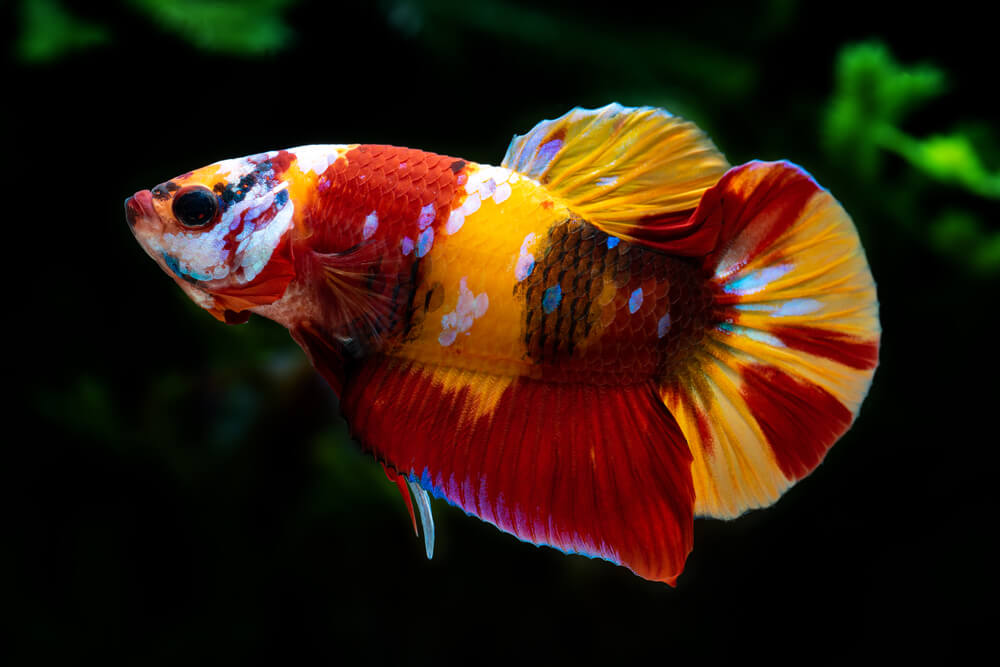
So which tank mates should be avoided? Any sort of aggressive freshwater species, such as Tiger Barbs, Arowanas, Cichlids, or larger species that may think of the betta fish as a meal should be avoided at all costs.
Breeding Galaxy Koi Betta
Breeding Galaxy Koi Betta is not an easy task. If you’re fortunate enough to have both a male and female Galaxy Koi pair, you can’t just add them to an aquarium and expect them to lay eggs that hatch into fry and grow up to be eye-catching bettas.
First, you’ll want to make sure you have a healthy male/female pair. Store-bought Bettas from a large pet shop tend to be treated poorly. Purchasing from a reputable breeder will improve the chances that your fish will pair up and lay eggs. You’ll want to keep your female betta fish in a separate tank as you prepare for breeding.
Once you’ve selected your male, you’ll need to acclimate this fish to a breeding tank. The breeding tank should be at least 10 gallons, and its purpose is to house betta fry after the eggs hatch. You must monitor the water conditions for this tank, you can fill this aquarium with existing tank water, combined with fresh tap water. The breeding tank should be established and have a filter. You must provide a heater for this tank, and you’ll want to maintain temperatures of around 82°
Once you’ve established the breeding tank, you can start feeding both the male and female high-quality live food, such as bloodworms to prepare them for breeding. After consuming a healthy diet for at least a week, you can now introduce the female Galaxy Koi Betta to the breeder tank.
Now, keep an eye on the fish! Occasionally males may act overly aggressive at this stage. If that’s the case, you should remove the female and try again a few days later. You’ll need to exercise good judgment here. A small amount of chasing and fin-nipping is normal, but too much of this can stress the female.
If the male fish isn’t showing overt signs of aggression, you should start to notice the male building a bubble nest. The female should also begin to display vertical bars on her body, indicating that she is ready to breed.
The fish will wrap themselves around each other and the female will release eggs, which the male will then pick up with his mouth and place into a bubble nest. Once the male starts placing eggs, you are one step closer to successfully breeding Galaxy Koi Bettas!
But there is still more work to do. The most difficult part is the next stage - raising the fry.
After the eggs have been laid, you can remove the female. Eggs will hatch typically within 4 days of being laid. You can examine the development of the eggs by looking for black dots, which are the eyes of the fry! Some of the eggs will be consumed by the male betta fish, as these eggs are unfertilized, making for a nutritious treat for the male betta.
Once the fry start to hatch, they will slowly start to swim around the tank. At this point, you can remove the male galaxy koi, as their job is done. You’ll need to carefully feed the fry 2-4 times a day with microworms. Microworms are roundworms that can be consumed by fry. You can create a micro worm culture by purchasing a starter culture online and following provided instructions
Over a 7-day period, you can slowly add water to the breeding tank. You’ll want to evenly distribute new water, additions of about 5% of the total volume of aquarium water each day should suffice.
After a week has passed, you can start feeding baby brine shrimp. Betta Fry have a very fast metabolism, so you’ll need to continue feeding microworms 2-3 times a day, with the addition of baby brine shrimp at least once a day for an additional week.
Continue to feed the Galaxy Koi fry their new diet for at least a week. At this point, your fry should be at least 3 weeks old. Congratulations, you’ve made it past the “danger zone” and you can now transfer your fry to a larger aquarium if needed!
Maintain daily water changes, around 15% to keep the water chemistry levels stable. You can slowly start feeding baby brine shrimp exclusively for the next week or so. Towards the tail end of this period, you can start to feed the fry dry food.
At this point, your fry should be at least 5 weeks old. Continue to do water changes and maintain good water chemistry levels for the next few weeks, and you’ll have successfully raised Galaxy Koi Betta fry!
Where can I buy a Galaxy Koi Betta?
Galaxy Koi Betta can occasionally be found for sale in our Betta fish section, JVBetta, eBay, and occasionally appear in local fish stores.
In Summary
Now you have all of the knowledge needed to successfully keep Galaxy Koi Betta fish. Although it might seem a bit overwhelming, keeping this fish can be an incredibly rewarding experience.
Galaxy Koi do well in a species-only tank, or in a large aquarium where they have at least 5 gallons of territory for themselves. This post should have given you all of the tips needed to give your fish a great life.
Overall, we love the Galaxy Koi color variation of Betta splendens, and recommend them to anyone who can get their hands on one!
January's Giveaways on Light Fish


